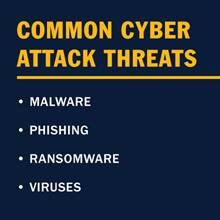Cyber Security

Preferred IT Solutions is Hiring!
May 22, 2023
Preferred IT Solutions shoutout from Tim Pool on TimCast IRL! Check us out!
June 19, 2023Cyber Security

Group of SMM specialists working on social media marketing strategy to achieve business goals. Hologram icons over Bangkok background.
In recent years, headlines about cyber security have become increasingly common. Thieves steal customer social security numbers from corporations’ computer systems. Unscrupulous hackers grab passwords and personal information from social media sites or pluck company secrets from the cloud. For companies of all sizes, keeping information safe is a growing concern.
What Is Cyber Security?
Cyber security consists of all the technologies and practices that keep computer systems and electronic data safe. And, in a world where more and more of our business and social lives are online, it’s an enormous and growing field with many types of job roles.
According to the Cyber Security & Infrastructure Security Agency (CISA), “Cyber security is the art of protecting networks, devices and data from unauthorized access or criminal use and the practice of ensuring confidentiality, integrity and availability of information.”
What Is Information Security?
Information security is the processes and tools designed and used to protect sensitive business information from modification, disruption, destruction and inspection, according to CISCO.
Information security and cyber security are often confused. According to CISCO, information security is a crucial part of cyber security but is used exclusively to ensure data security.
Everything is connected by computers and the internet now, including communication, entertainment, transportation, shopping, medicine and more. A copious amount of personal information is stored among these various services and apps, which is why information security is critical.
Why Is Cyber Security Increasingly Important?
Getting hacked isn’t just a direct threat to the confidential data companies need. It can also ruin their relationships with customers and even place them in significant legal jeopardy. With new technology, from self-driving cars to internet-enabled home security systems, the dangers of cybercrime become even more serious.
So, it’s no wonder that international research and advisory firm Gartner Inc. predicts worldwide security spending will hit $170 billion in 2022, an 8% increase in just a year.

These days, the need to protect confidential information is a pressing concern at the highest levels of government and industry. State secrets can be stolen from the other side of the world. Companies whose whole business models depend on control of customer data can find their databases compromised. In just one high-profile 2017 case, personal information for 147.9 million people – about half the United States – was compromised in a breach of credit reporting company Equifax.
What Are Cyber Attacks?

There are many reasons behind a cyber attack, such as cyber warfare, cyber terrorism and even hacktivists, but these actions fall into three main categories: criminal, political and personal.
Attackers motivated by crime typically seek financial gain through money theft, data theft or business disruption. Similarly, personal attackers include disgruntled current or former employees who will take money or data in an attempt to attack a company’s systems. Socio-political motivated attackers desire attention for their cause, resulting in their attacks being known to the public, and this is a form of hacktivism. Other forms of cyber attacks include espionage, or spying to gain an unfair advantage over the competition, and intellectual challenging.
According to CISA, as of 2021, there is a ransomware attack every 11 seconds – a dramatic rise from every 39 seconds in 2019 (CISA PDF Source). In addition, small businesses are the target of nearly 43% of all cyber attacks, which is up 400%.
The Small Business Association (SBA) reports that small businesses make attractive targets and are typically attacked due to their lack of security infrastructure. The SBA also reports that a majority of small business owners felt their business was vulnerable to an attack. This is because many of these businesses:
- Can’t afford professional IT solutions
- Have limited time to devote to cyber security
- Don’t know where to begin
What Are Types of Cyber Attacks and Threats?
Here are some of the most common threats among cyber attacks:
- Malware: Malware, also known as malicious software, is intrusive software developed by cyber criminals to steal data or to damage and destroy computers and computer systems, according to CISCO. Malware has the capability of exfiltrating massive amounts of data. Examples of common malware are viruses, worms, trojan viruses, spyware, adware and ransomware.
- Phishing: Phishing attacks are the practice of sending fraudulent communications while appearing to be a reputable source, according to CISCO. This is typically performed via email or on the phone. The goal is to steal sensitive information such as financial or login information – or to install malware onto a target’s device.
- Ransomware: Ransomware is a form of malware designed to encrypt files on a target device, rendering those files and the systems they rely on unusable, according to the CISA. Once the system has been encrypted, actors demand ransom in exchange for decryption.
- Viruses: A virus is a harmful program intended to spread from computer to computer, as well as other connected devices, according to the SBA. The object of a virus is to give the attacker access to the infected systems. Many viruses pretend to be legitimate applications but then cause damage to the systems, steal data, interrupt services or download additional malware, according to Proofpoint.
Who Is Behind Cyber Attacks?
Attacks against enterprises can come from a variety of sources such as criminal organizations, state actors and private persons, according to IBM. An easy way to classify these attacks is by outsider versus insider threats.
Outsider or external threats include organized criminals, professional hackers and amateur hackers (like hacktivists).
Insider threats are typically those who have authorized access to a company’s assets and abuse them deliberately or accidentally. These threats include employees who are careless of security procedures, disgruntled current or former employees and business partners or clients with system access.
Developing Cyber Awareness

Cyber security awareness can mean different things to different people depending on their technical knowledge. Ensuring appropriate training is available to individuals is a great way to motivate lasting behavioral changes.
While cyber security awareness is the first step, employees and individuals must embrace and proactively use effective practices both professionally and personally for it to truly be effective, according to Forbes.
Getting started with cyber security awareness is easy, and many resources are readily available on the CISA government website based on your needs. Whether you need formal training or a monthly email with cyber security tips and tricks, any awareness and training can impact behavior and create a positive change in how you view cyber security.
What Are the Types of Cyber Security?
Here are the most common types of cyber security available:
- Application Security: Application security describes security used by applications to prevent data or code within the app from being stolen or hijacked. These security systems are implemented during application development but are designed to protect the application after deployment, according to VMWare.
- Cloud Security: Cloud security involves the technology and procedures that secure cloud computing environments against internal and external threats. These security systems are designed to prevent unauthorized access and keep data and applications in the cloud secure from cyber security threats, according to McAfee.
- Infrastructure Security: Critical infrastructure security describes the physical and cyber systems that are so vital to society that their incapacity would have a debilitating impact on our physical, economic or public health and safety, according to CISA.
- Internet of Things (IoT) Security: IoT is the concept of connecting any device to the Internet and other connected devices. The IoT is a network of connected things and people, all of which share data about the way they are used and their environments, according to IBM. These devices include appliances, sensors, televisions, routers, printers and countless other home network devices. Securing these devices is important, and according to a study by Bloomberg, security is one of the biggest barriers to widespread IoT adaption.
- Network Security: Network security is the protection of network infrastructure from unauthorized access, abuse or theft. These security systems involve creating a secure infrastructure for devices, applications and users to work together, according to CISCO.
www.snhu.edu


